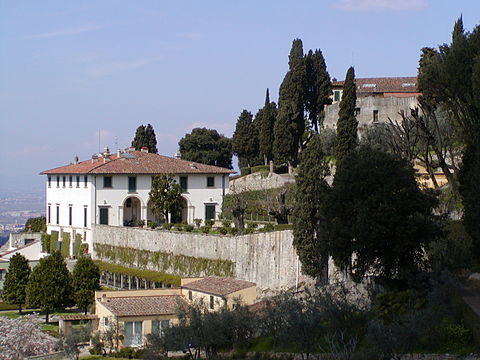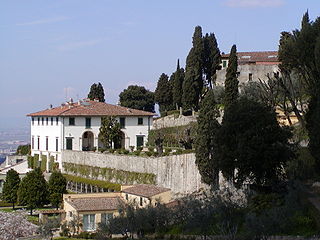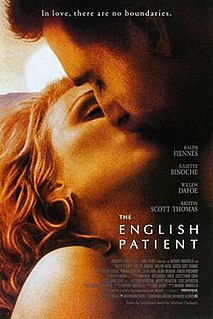
The English Patient is a 1996 British-American romantic war drama film directed by Anthony Minghella from his own script based on the novel of the same name by Michael Ondaatje and produced by Saul Zaentz. The film tells the story of Count László de Almásy, who is burned from a plane crash and tells his past story in flashbacks involving a romantic affair, while he is tended by a nurse.
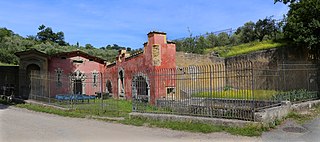
The Fonte della Fata Morgana, locally also called '"Casina delle Fate", at Grassina, not far from Florence, Italy, in the comune of Bagno a Ripoli, is a small garden building, built in 1573–4 as a garden feature in the extensive grounds of the Villa il Riposo of Bernardo Vecchietti on the slope of the hill called Fattucchia.

The Diocese of Fiesole is a Roman Catholic diocese in Tuscany, central Italy, whose episcopal see is the city of Fiesole. It is a suffragan of the Metropolitan Archbishopric of Florence.

The Villa Medici at Careggi is a patrician villa in the hills near Florence, Tuscany, central Italy.

Giovanni di Cosimo de' Medici was an Italian banker and patron of arts.

The Villa Medicea di Cafaggiolo is a villa situated near the Tuscan town of Barberino di Mugello in the valley of the River Sieve, some 25 kilometres north of Florence, central Italy. It was one of the oldest and most favoured of the Medici family estates, having been in the possession of the family since the 14th century, when it was owned by Averardo de' Medici. Averardo's son, Giovanni di Bicci de' Medici, is considered to be the founder of the Medici dynasty.

The Villa di Pratolino was a Renaissance patrician villa in Vaglia, Tuscany, Italy. It was mostly demolished in 1820. Its remains are now part of the Villa Demidoff, 12 km north of Florence, reached from the main road to Bologna.

Villa Le Balze is a garden villa in Fiesole, a comune of the Metropolitan City of Florence and the region of Tuscany in central Italy. The villa was commissioned and built by Charles Augusts Strong in 1913, where he spent much of his life. It was then embroiled in the fighting of the Second World War and came into the possession of Margaret Rockefeller Strong. The villa is today owned by Georgetown University and hosts year-round study abroad students focused on interdisciplinary study of Italian culture and civilization, as well as such other subjects as politics and history.

The Medici villas are a series of rural building complexes in Tuscany which were owned by members of the Medici family between the 15th century and the 17th century. The villas served several functions: they were the country palaces of the Medici, scattered over the territory that they ruled, demonstrating their power and wealth. They were also recreational resorts for the leisure and pleasure of their owners; and, more prosaically, they were the centre of agricultural activities on the surrounding estates. In 2013, the Medici villas were added to UNESCO's World Heritage list.
Piazzale Michelangelo is a square with a panoramic view of Florence, Italy, located in the Oltrarno district of the city.
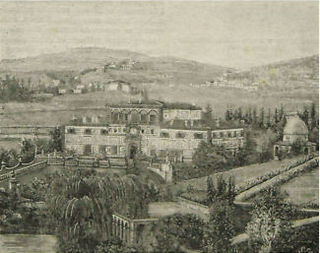
Villa Palmieri is a patrician villa in the Fiesole, central Italy, that overlooks Florence. The villa's gardens on slopes below the piazza S. Domenico of Fiesole are credited with being the paradisal setting for the frame story of Boccaccio's Decameron.

The Villa del Trebbio is a Medici villa in Tuscany, Italy.

The Villa di Montevettolini is a Medici villa in the comune of Monsummano Terme, Tuscany, central Italy.

The Villa L'Ambrogiana was a rural palace or villa built during the late-renaissance by Ferdinand I de' Medici; it is located at the confluence of the rivers Pesa and Arno, in the municipality of Montelupo Fiorentino.

The Church of San Girolamo is building complex that includes a villa, olive grove, and former Catholic monastery and church located on Via Vecchia Fiesolana in Fiesole, Tuscany. It is often known as Villa San Girolamo.

The Episcopal Palace is a building located in Piazza Mino of Fiesole, Italy. Built in the 11th century, it serves as the residence of the Bishop of Fiesole.
